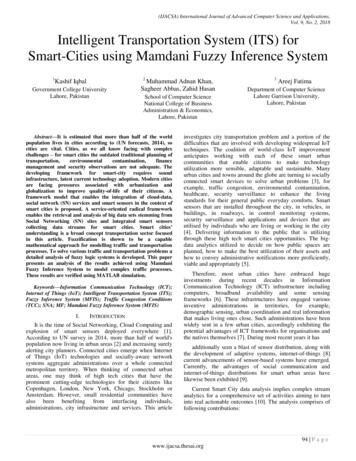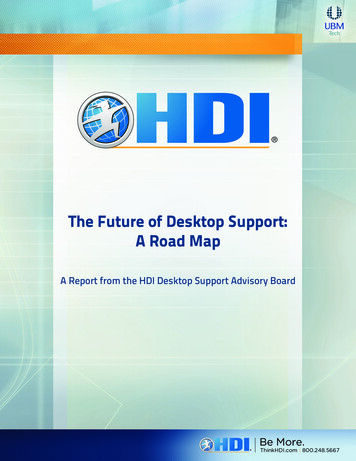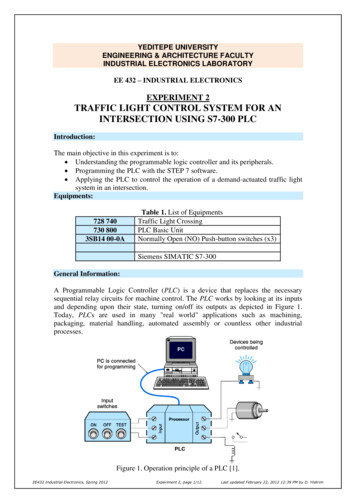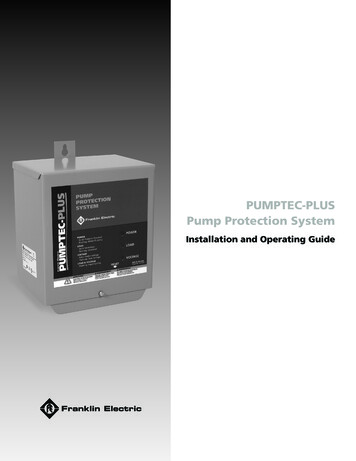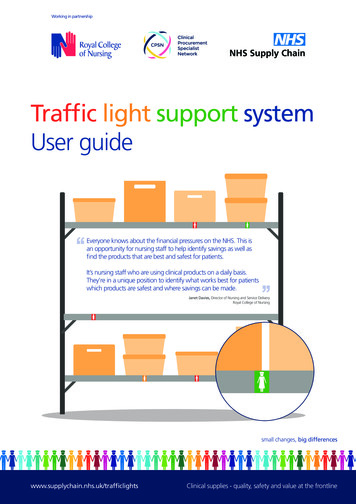
Transcription
Working in partnershipTraffic light support systemUser guideEveryone knows about the financial pressures on the NHS. This isan opportunity for nursing staff to help identify savings as well asfind the products that are best and safest for patients.It’s nursing staff who are using clinical products on a daily basis.They’re in a unique position to identify what works best for patientswhich products are safest and where savings can be made.Janet Davies, Director of Nursing and Service DeliveryRoyal College of Nursingsmall changes, big nical supplies - quality, safety and value at the frontline
How it worksUse the stickers in your main stockrooms and anyadditional storage areas, to label the shelves theproducts sit on, or on the permanent box they arestored in.ThinkConsiderGoPlease use this highcost item with care.Could you still use aless expensive item?Good choice, this willhelp you make savingsCould a lessexpensive product dothe same job?Use the amber nurse onthe middle priced productoption (if there is one)Use the green nurseon the lowest pricedproduct optionUse the red nurse on thehigher priced product optionwww.supplychain.nhs.uk/trafficlights
The type of products your traffic light support systemcould include Small, multiple, consumable easy-to-use products that are used for similar purposes. Products available from multiple suppliers may cause challenges due to the regular changes in supplier andmay not be suitable for the system. Not all products within clinical areas may be suitable. A small, easy-to-use selection of products may bepreferable here to aid manageability and effectiveness.Examples of products and the type of considerations the system should encourage - for illustrationpurposes only. Dressings - could you use a less expensive item to do the same job? Blunt filter needle - are you drawing up from a glass ampoule? If not use a blunt fill. Syringe - do you need a luer lock? Surgical tapes - if it’s not for a specialist patient care use can you use the lower cost tape?Why should you and your trust support thetraffic light support system?It will help you to take control and make a difference, supporting you to: Deliver patient care whilst also driving efficiencies and value. Identify lower cost alternatives, that are still fit for purpose. Develop an increased awareness and knowledge of the cost of products you use, giving your teams theskills and information needed to help you treat items with the correct level of care, buy better and save. Grow a shared knowledge across your teams and the trust. Continue to focus on patient care - it’s a simple change that won’t take any of your time away.What could the savings mean to you and your trust? Every 10 saved could equate to an online PREP 10 credit module. Every 30,000 saved could equate to a band 5 nurse. Every 40,000 could equate to developing the career pathway for a band 6 nurse. That your department makes the savings it needs. That your trust makes the savings it needs.Clinical supplies - quality, safety and value at the frontline
Getting started12AssessLaunch Think! Who needs to be involved in developing and launchingyour traffic light support system?Agree your support team. e.g. Head Of Procurement (HoP), Materials Place the stickers on the shelves andpermanent product storage boxes. Let everyone know what you’re doing- encourage senior members and support teamsto cascade information to all, use the posters andmake the user guides easily available in stockrooms and racking systems in clinical areas etc. Brief your teams – make clear why you areundertaking this project, encouraging andempowering your teams to make choices whichcan contribute to patient safety, support thefrontline and deliver savings whilst still retainingclinical choice. Share the potential benefits of the systemand the specific objectives for your trust - e.g.standardised products on the shelf that are easierfor clinical staff to find supporting improvedpatient safety, with time and money saved. Make clear why working together is soimportant - everyone has a valuable part to playto ensure the success of the system.Management, Chief Nurse, Infection Prevention and Control, Director ofServices Surgery/Medicine etc (nurse), Selected Area Nurse Leads etc. Visit your HoP - it is essential procurement are fully engagedfrom the outset. Materials Management / Procurement Lead - ask your HoPto arrange a meeting with Materials Management. Securinga lead to help you identify which areas are most suitable for thesystem is crucial. Identify your selection criteria and agree whichproducts, stockrooms and additional storage areasare suitable: The system is for use with existing working stock Run your Trust Reports (TRs) to see exactly what products youare using across the trust Look for opportunities where more than one product couldbe used for same/similar procedure i.e. differing suppliers,differing sizes etc Look for high value items that should always be handledwith care. Agree timescales. Agree how you will measure the success of the system.Consider Applying a consistent set of criteria against all products- this will make it easier to understand and measure thesuccess of the total system. Piloting the system over a handful of clinical areas - thiscan help you identify which products and areas work best foryour trust, before a wider roll-out. Keep the number of products you are applying thesystem to, manageable - depending on the size of the storeroom/department, to prevent ‘blindness’ and non-compliance. Trust Report (TRs) are a useful tool - talking to clinical staffin the area alongside the Materials Management team isessential to ensure the project is real and works for all clinicalteams involved. Always share information - across your support team andwith all relevant departments to agree and ensure onecompliant approach to the er Materials Management support - can theysupport you to ensure the lower priced greenand amber products are located next to the redproducts in your stockroom for ease-of-selection? Not putting stickers on disposable items- as this would mean new stickers wouldconstantly need reapplying, adding workload foryour Materials Management Team. Display posters and user guides - so they arenever too far away from any stickers. Even insmaller storage areas multiple posters and userguides may need to be used to ensure they arevisible in these busy environments. Briefing teams about the system - avoid extrawork and build briefings into the regularcatch-ups you have already.
34Keeping the project aliveEvaluate Raise awareness - keep the awareness posters in yourstockrooms and relevant communal areas, provide regularupdates at team meetings. Trust support team contact - ensure a support team contactname is written on the posters to ensure you can answer andsupport your teams with any questions they may have. Keep the project moving at pace - keep in touch withyour teams and agree from the outset how you will shareproject updates e.g. send monthly emails to leads in chosenareas to see how it is progressing, ask if they need furthermaterial support, encourage them to have catch-ups withtheir teams to find out how they are getting on and if theyhave any new ideas they may have for how the traffic lightsupport system could be used. Measure - continually check back against youragreed key milestones and success criteria. Share results - with your teams and wider truston a regular basis. Lessons learned - ensure you and your teamscontinually share key learnings and take anyrelevant action needed, making sure your systemcontinues to evolve and support the specificneeds of your trust.In order to deliver on-going efficiencies in the purchase and use of clinicalsupplies and further support the reduction in levels of potential risk ofharm to patients, working collaboratively with your relevant clinical nursingteams is essential.For progress to be made and importantly sustained for those involved,ensuring they see the value of the task ahead and fully understand the‘why’, ‘what’, ‘how’ and ‘when’, is critical.David Barwell, Head of ProcurementThe Pennine Acute Hospitals NHS TrustInfection Prevention and Control supportWhilst the stickers are wipeable and can easily be removed, it is important you work with your InfectionPrevention and Control teams, as they can help you implement the system ensuring it meets all yourInfection Prevention and Control requirements. For example: 1) not applying new stickers on top of oldstickers and making sure where you place the sticker is prepped and clear of residue; 2) not applyingstickers in areas where there is a high chance of the build-up of dirt.Clinical supplies - quality, safety and value at the frontline
Case studyDeveloping the traffic light support system withPennine Acute Hospitals NHS Trust (PAT) Learn how PAT formed their traffic light support system project team - ensuring they had the rightcross functional support from the beginning. Find out how they identified across which sites to pilot the system - from the largest storeroom inAccident and Emergency to the smallest in surgery. See how they identified an acceptable selection of clinical supplies - to pilot the system with. See how they helped develop the system - to ensure it met their requirements. See the results - how the teams have benefited from the traffic light support system.Left to right: Natalie O’Mahony, Assistant Operations Manager, PAT;Karen Hudson, Clinical Nurse Advisor, NHS Supply Chain;Shelley Scothorne, Clinical Communications Executive, NHS Supply Chain;Sue Buckley, Sister, PAT; Sheila Smith, Senior Supplies Assistant, PATView the full case study: www.supplychain.nhs.uk/trafficlightsNHS Supply Chain does not endorse, favour or recommend any other party’s products, processes or services that may feature in this case study.Accordingly, the appearance of any such products, processes or services in this case study may not be used in any third party advertising or product endorsement purposes.www.supplychain.nhs.uk/trafficlights
I now have an awareness of thecost of some clinical supplies I usedue to the traffic light supportsystem and will use alternativeclinical supplies where possible, aslong as it is the right decision forthe patient.’Healthcare Assistant,Pennine Acute Hospitals NHS TrustKey is that the traffic lightsupport system has the potentialto help nursing teams driveefficiencies in a way that can beeasily adopted into their alreadyincredibly busy days, so that mostimportantly, they can continue tofully focus on patient care.Natalie O’Mahony, Assistant Operations ManagerPennine Acute Hospitals NHS TrustClinical supplies - quality, safety and value at the frontline
Every pound saved couldbe a pound towardsfront line services andhelp the trust meet itssavings targets.Small Changes, canmake big differences.Order your FREE traffic light support system starter pack,download the user guide and case study.www.supplychain.nhs.uk/trafficlightsLearn more about the campaign and see how you can get involved:www.rcn.org.uk/smallchanges0069Any questions or for more information on the different ways NHS Supply Chain can support yourtrust to drive efficiencies, save and support the frontline, contact your Trust Procurement.Clinical Supplies Quality, Safety and Value at the Frontline
due to the traffic light support system and will use alternative clinical supplies where possible, as long as it is the right decision for the patient.’ Healthcare Assistant, Pennine Acute Hospitals NHS Trust Key is that the traffic light support system has the potential to h





